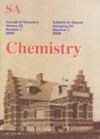Pollution assessment of antimony in shooting range soils
IF 0.8
4区 化学
Q4 CHEMISTRY, MULTIDISCIPLINARY
South African Journal of Chemistry-Suid-Afrikaanse Tydskrif Vir Chemie
Pub Date : 2022-12-01
DOI:10.17159/0379-4350/2022/v76a11
引用次数: 1
Abstract
Soil samples collected from the berm at Thebephatshwa (TAB) shooting range found in Botswana showed variable total concentrations of antimony in the range 38±1 to 283±12 mg/kg. Total antimony concentrations found in the soils were higher than the set regulatory levels by the World Health Organization (36 mg/kg) and the United States Protection Agency (31 mg/kg). The upper berm showed elevated levels of antimony (283±12 mg/kg) due, in part, to the highest density of spent projectiles found in this part of the berm. Sequential extraction studies established that antimony was partitioned mostly in the organic and residual fractions of the soil. Environmental pollution risk assessment based on geoaccumulation index (Igeo), contamination factor (CF) and enrichment factor (EF) indicated all four sections of the berm posed high risk to the environment. The upper berm exhibited extreme pollution from antimony (Igeo ~9), very high contamination (CF ~744) and extreme antimony enrichment (EF ~506) compared to the other three sections studied. Elevated levels of antimony at TAB shooting range call for best shooting range management practices, soil remediation and reclamation methods to be carried out at this shooting range to minimize the mobility and bioavailability of antimony.射击场土壤中锑污染评价
从博茨瓦纳Thebephatshwa (TAB)射靶场的护坡上采集的土壤样本显示,锑的总浓度在38±1至283±12毫克/公斤之间。土壤中发现的总锑浓度高于世界卫生组织(36毫克/公斤)和美国保护署(31毫克/公斤)规定的管制水平。上护堤显示锑水平升高(283±12毫克/公斤),部分原因是在这部分护堤中发现的废弹密度最高。序贯提取研究表明,锑主要分布在土壤的有机组分和残余组分中。基于地质累积指数(Igeo)、污染因子(CF)和富集因子(EF)的环境污染风险评价表明,4个断面均存在较高的环境污染风险。与其他3个断面相比,上滩表现出严重的锑污染(Igeo ~9),非常高的污染(CF ~744)和严重的锑富集(EF ~506)。TAB射击场锑含量升高,需要在该射击场实施最佳射击场管理措施、土壤修复和开垦方法,以尽量减少锑的流动性和生物利用度。
本文章由计算机程序翻译,如有差异,请以英文原文为准。
求助全文
约1分钟内获得全文
求助全文
来源期刊
CiteScore
3.10
自引率
0.00%
发文量
6
审稿时长
>12 weeks
期刊介绍:
Original work in all branches of chemistry is published in the South African Journal of Chemistry. Contributions in English may take the form of papers, short communications, or critical reviews.

 求助内容:
求助内容: 应助结果提醒方式:
应助结果提醒方式:


